The best photographs of 2015
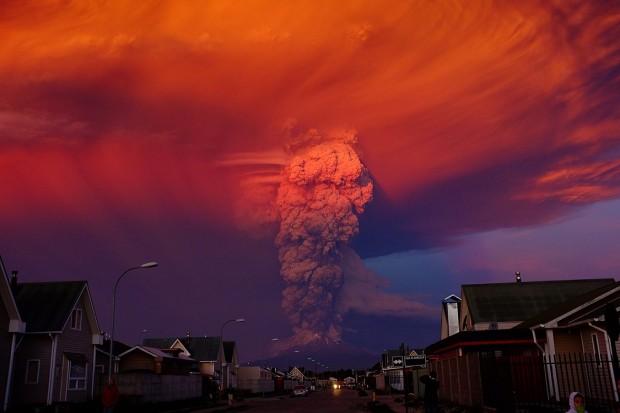
The Guardian
Blood moon eclipses, volcano eruptions, Usain Bolt’s Segway crash and Caitlyn Jenner’s Vanity Fair cover … photographers explain how they got their shots:
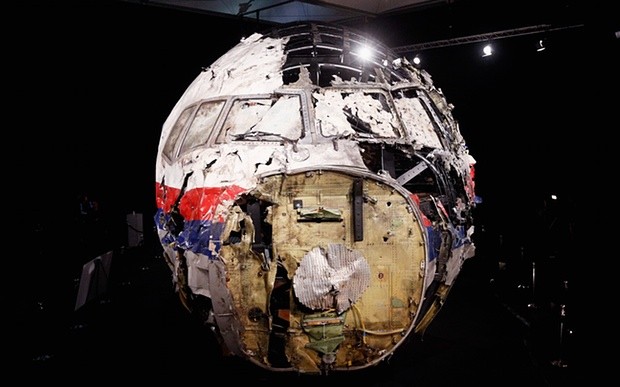
Remains of Malaysian Airlines flight MH17
Dean Mouhtaropoulos/Getty Images
13 October As a sports photographer I don’t usually cover news. But I live near the airfield in the Netherlands where the Dutch Safety Board report into the downing of MH17 was being released, so I went along to cover it. This was the first time they described what the missile was (a Russian Buk), what the launch system was, and exactly what happened to the plane once it had been hit.
We went inside the plane. It had been recovered from Ukraine, and reconstructed like a jigsaw in a hangar. We walked through the skeleton of the fuselage, where a year ago there were families. That was the part that got to me the most. Everyone connects with being on a plane. That’s what makes this a strong image. It affected me quite badly. Being in the cockpit and seeing where the shrapnel had gone through the chairs, the description of how the plane broke up when the missile blew up. People who cover war and disasters learn how to detach themselves, otherwise you won’t survive. That’s why I could never be a war photographer – I can’t detach myself.
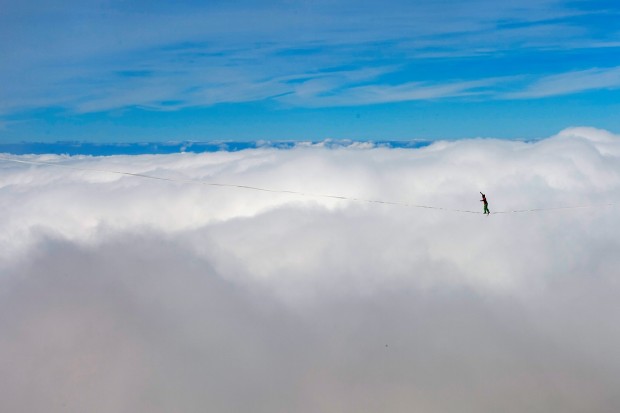
Highline walk
Jean-Christophe Bott/EPA
26 September The highline was strung between two sides of Moléson Peak, a mountain which curves round at the top like a circle in the Swiss Prealps. The peak is 2000m, just up above this huge area of sea fog, and sometimes the figure and the rope would disappear in the cloud. There were about 20 guys taking it in turns to walk the entire length of the highline without falling off, and they couldn’t do it. They kept falling. They were attached with a little rope, but I still had vertigo watching them.
For these guys, walking across the rope without falling is a personal and artistic achievement. The highlines are always getting longer and getting higher. Here you really get a sense of the difference between this giant area of fog, and the little guy. It’s about man fighting nature, fighting the elements, and fighting against fear.
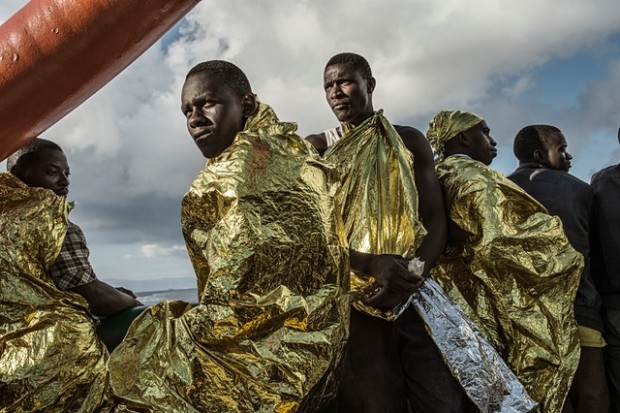
Refugees rescued from the sea
Francesco Zizola/NOOR
23 August I was invited by Médecins Sans Frontières to document search and rescue in the Strait of Sicily. During the three weeks I was on board the ship, I witnessed the rescue of more than 3,000 migrants.
This image portrays a group of migrants, still wrapped in the shiny emergency blankets they used to keep warm during the two nights they spent on deck. After their long and troubled journey, this is the moment they catch sight of the land where they have long dreamed to arrive: Europe. The man in the forefront seems to know the land he is seeing may not be as welcoming as they all wish, and that he should not let his hopes run too wild.
On a crowded boat like this, the most critical aspect for a photographer is not what camera/lens combination to use, but how to be discreet and respectful. I hope that my images force people to put themselves in the shoes of those who risk everything to cross the Mediterranean and change the minds of those who don’t want to open the doors of their countries to them.
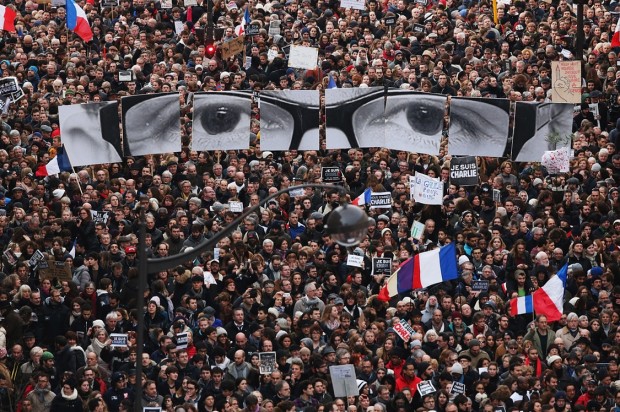
Charlie Hebdo unity march
Christopher Furlong/Getty Images
11 January The eyes were made by a French artist called JR and all credit goes to him, because he made this picture, not me. They are the eyes of Stéphane Charbonnier who was the editor of Charlie Hebdo. We knew there was going to be a massive unity march and the best way to show the maximum number of people was from up high. It was quite difficult to find that spot, because all the residents around the Place de la République had been told by the police not to allow any strangers on their roofs or balconies for security reasons. In the end a colleague and I managed to book a room in a hotel where I shot this.
The image shows the very beginning of the march, where it started on Rue Voltaire. I captured the eyes in the top of the frame – a classic rule of thirds composition. It was amazing and incredibly humbling to see so many people united together with one voice. I felt privileged to be able to take this photograph.
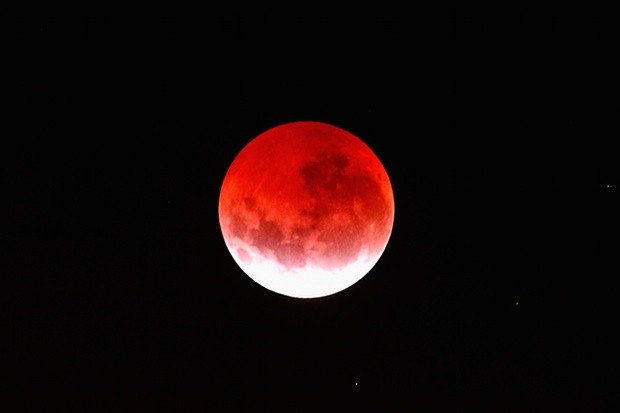
‘Blood moon’ eclipse
Phil Walter/Getty Images
4 April I heard that the lunar eclipse “blood moon” was going to take place, but it was so late at night that it wasn’t a big spectator event in New Zealand. It had been cloudy most of the day and I wasn’t sure if we were going to see the eclipse or not, but we were lucky and it cleared up.
I shot the eclipse from my front porch using a 600mm lens on a tripod, and took maybe 50 or 60 pictures. I really wanted to place the moon next to something land-based, like a building or a church steeple, but it wasn’t a low moon sitting on the horizon. In fact it was quite hard to focus, because the camera was at an acute angle – pointing straight up into the sky – which is difficult when you’re using such a big lens. I didn’t edit this image at all, but you can alter the white-balance settings in the camera, which gave it a warmer, more saturated feel. But even with the naked eye you could see the reddish tinge.
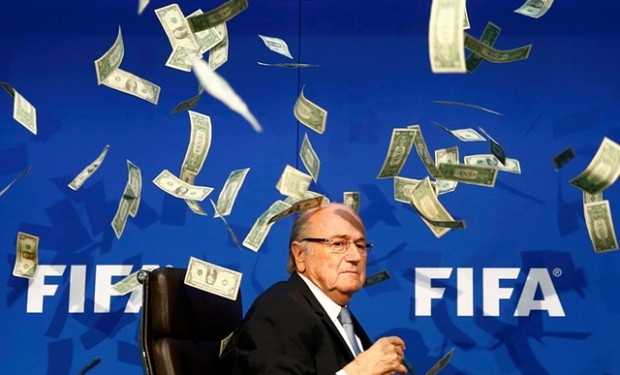
A shower of banknotes for Sepp Blatter
Arnd Wiegmann/Reuters
20 July We were gathered for the news conference after the Fifa executive committee meeting in Zurich. Suddenly this guy wearing a suit stood up at the front and went towards Blatter. We found out later he was the British comedian Simon Brodkin. He had two packets of dollar notes. Blatter was surprised and started saying, “Where’s my security?” When the guards arrived Brodkin turned towards Blatter and threw the bank notes in the air. I had been using a zoom lens, but I quickly changed it for a wide angle lens. The entire situation was a bit less than 20 seconds and I shot 80 frames as the notes fell slowly and perfectly around Blatter.
I love this picture because it is not the Sepp Blatter we know. He looks helpless, and his eyes look a little sad.

Usain Bolt is felled by a Segway cameraman
Rolex dela Pena/EPA
27 August Usain Bolt had just won the 200m at the Beijing World Championships. He started doing his victory lap, and I decided to follow him with my camera, just to see if anything else happened. Camera operators on Segways were a new thing – very unusual. One camera guy was following Bolt, when all of a sudden he hit him from behind. I clicked my camera at that moment – it was accidental. My first thought was: I hope Bolt’s all right. It was a scary moment. But Bolt got up and seemed to be OK.
One photographer said to me: “You’re proof that it pays to wait”. The victory walk is just an ordinary moment. But I wanted to capture something different, and I guess I got it.
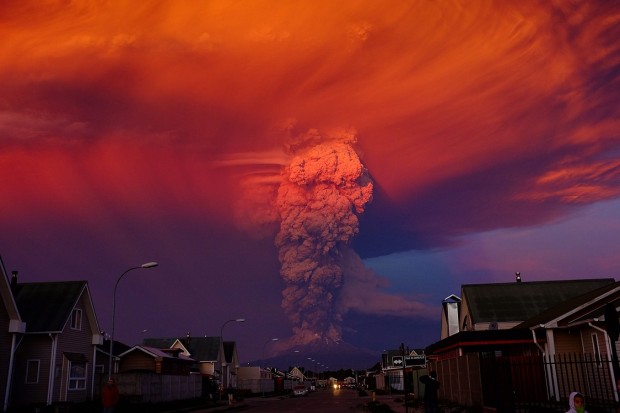
Chile’s Calbuco volcano erupts
Alex Vidal Brecas/EPA
22 April When the Calbuco volcano started erupting, I was getting ready to celebrate my birthday. We were about 30km from Puerto Montt, the city closest to the volcano. I got a call from a news agency asking me to get an image of the volcano that also encapsulated the real threat to the population. It was the first time the Calbuco had erupted in 43 years. At first no one noticed, but soon people were freaking out, as it’s impossible to predict how dangerous a volcano will be.
The opportunity for the photo came at dusk, 45 minutes after the eruption. I took others, but they don’t have the same colour scheme. I didn’t have my usual equipment with me – just a small compact camera.
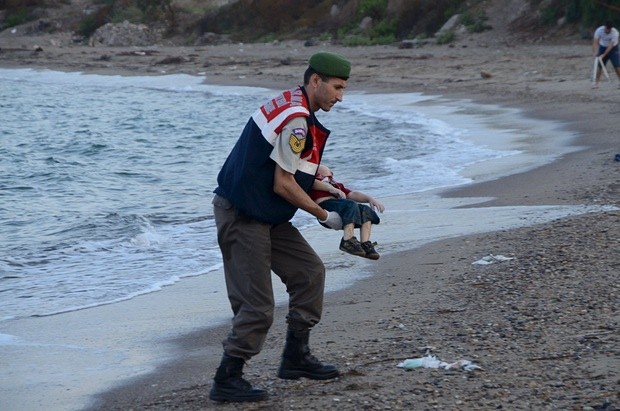
The body of Alan Kurdi
Nilufer Demir/DHA
2 September Speaking to Turkey’s Dogan News Agency (DHA), Demir said: “At that moment, when I saw the three-year-old Alan Kurdi, I was petrified. The only thing I could do was to make his outcry heard. At that moment, I believed I would be able to achieve this by clicking the shutter of my camera, and I took his picture.
“We were covering the illegal transition of migrants to the Greek island of Kos from Bodrum’s coast. Suddenly we noticed the lifeless bodies. We recognised they belonged to toddlers. We were shocked, we felt sorrow for them. I have photographed and witnessed many migrant incidents since 2003 in this region – their deaths, their drama. I hope from today, this will change.”
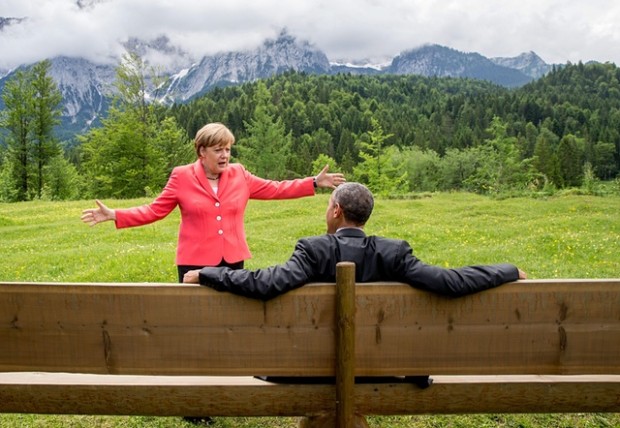
Merkel and Obama’s private moment
Michael Kappeler/EPA
8 June We had just done a big picture with all the heads of state on that bench which is in front of Schloss Elmau [the G7 summit venue]. I spotted Obama sitting alone and I thought: that’s a nice picture. I tried to take it, but there were lots of security guards. Merkel arrived and suddenly I found my chance. The moment Merkel opened her arms was less than a second. There was no one directing the shot. It was an accident. The picture was used on front pages all over the world.
How to submit an Op-Ed: Libyan Express accepts opinion articles on a wide range of topics. Submissions may be sent to oped@libyanexpress.com. Please include ‘Op-Ed’ in the subject line.
- Libya’s HCS invites applicants for key state roles - December 31, 2023
- UK calls on Iran to prevent escalation in Israel-Hamas conflict - November 05, 2023
- Libyan Interior Minister: Immigrant shelter costs a fortune - November 05, 2023


